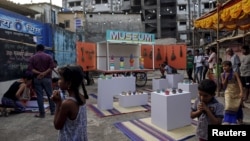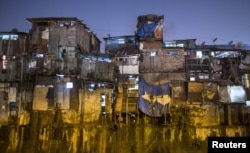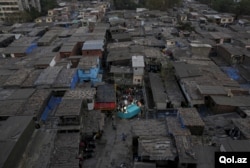A mobile museum in Mumbai's Dharavi is highlighting the skills and creativity of residents of one of Asia's largest slums, in an attempt to dispel the negative image of urban slum dwellers.
The Design Museum Dharavi, which will travel through the area with different exhibits for about two months, was conceived by Amsterdam-based artist Jorge Mañes Rubio with art historian Amanda Pinatih. They were aided by local artists and designers.
The museum reflects the nomadic nature and disparate skills of the more than 1 million people who live in Dharavi and are largely migrants from across India.
Items on display - arranged on and around a colorful handcart - include clay tea cups and saucers, terracotta water filters, reed brooms, painted wooden objects and textiles, all made with local or recycled materials.
"They live in a crowded space, in tough conditions, yet they are constantly creating, designing, manufacturing and commercializing all kinds of goods," said Rubio, who was impressed with Dharavi when he first visited four years ago.
"There is so much creativity here, and they are constantly reinventing themselves. Yet we insist on having a biased perspective about slums and the people in them," he said.
The sprawling slum in the heart of Mumbai is a lively amalgam of flimsy tarpaulin-covered shacks, one-room brick tenements with tin roofs and multi-storied buildings, as well as schools, temples and mosques and scores of small businesses, ranging from auto repair shops to textile units.
Attempts to develop the 240-hectare (590-acre) area in the past decade have run into opposition from residents and activists, and there are now plans for a public-private partnership to build permanent homes and better amenities.
"What's so unique about Dharavi is that it's right in the middle of this big city, and there are businesses and craftsmen, some running their family businesses for four generations," said Pinatih. "Yet it's looked on as an eyesore, something not desirable. We want to change that perspective."
Mumbai, India's financial hub, has long been a magnet for migrants seeking better economic opportunities. But its high rents mean that about half the city's 22 million inhabitants live in slums, their shacks and open drains sitting cheek by jowl with gleaming high-rise apartments and luxury cars.
Dharavi has featured in several Bollywood movies, as well as the Academy award-winning "Slumdog Millionaire" (2009), which triggered a wave of slum tours and criticism of slum voyeurism.
The museum will seek to dispel some of the negative notions and encourage a greater respect for urban slums, Rubio said.
"Our main mission is to challenge our perception of slums, favelas, ghettos and other informal settlements around the world, and to acknowledge the citizenship and creativity of these people," he said. "They have so much to contribute."










